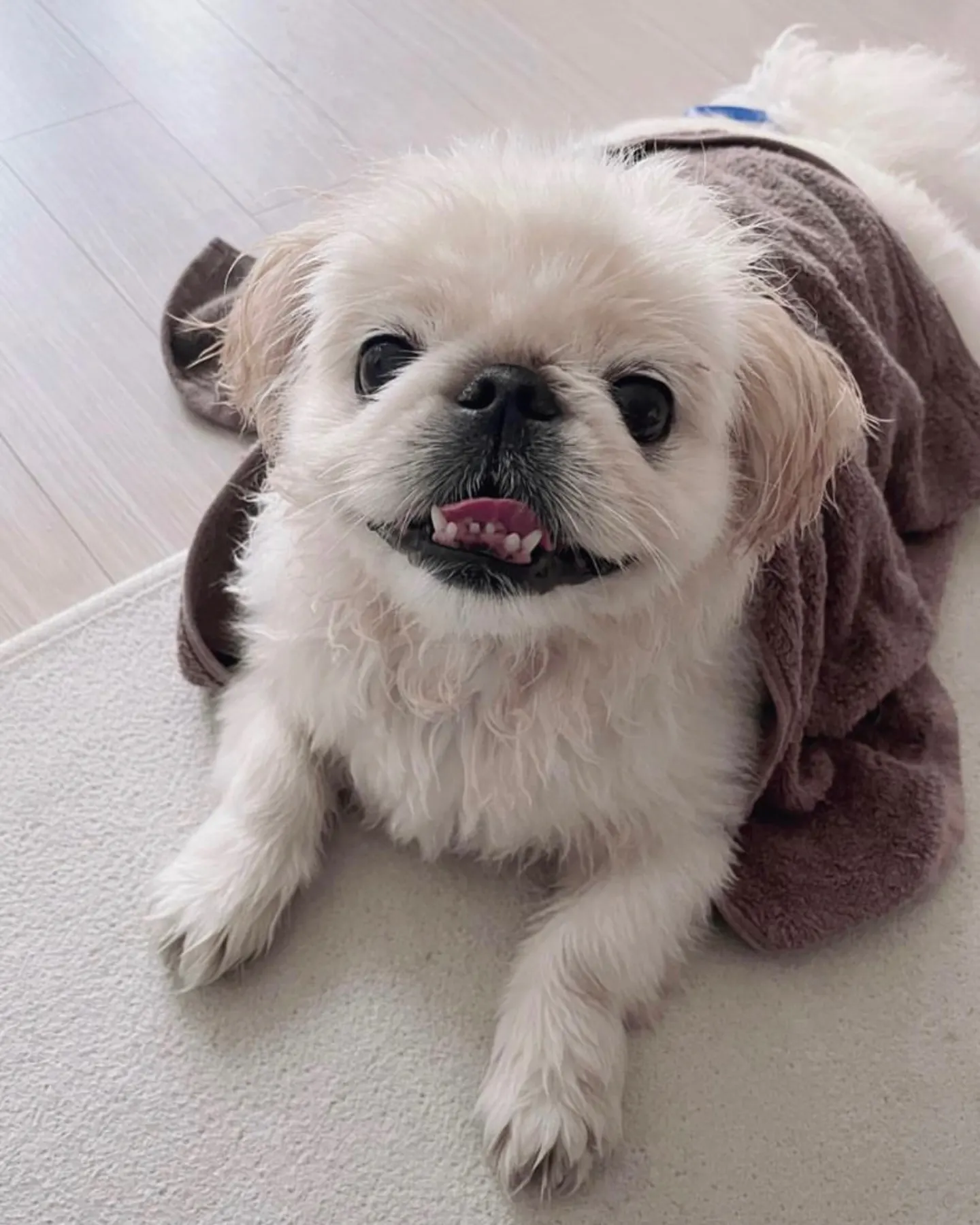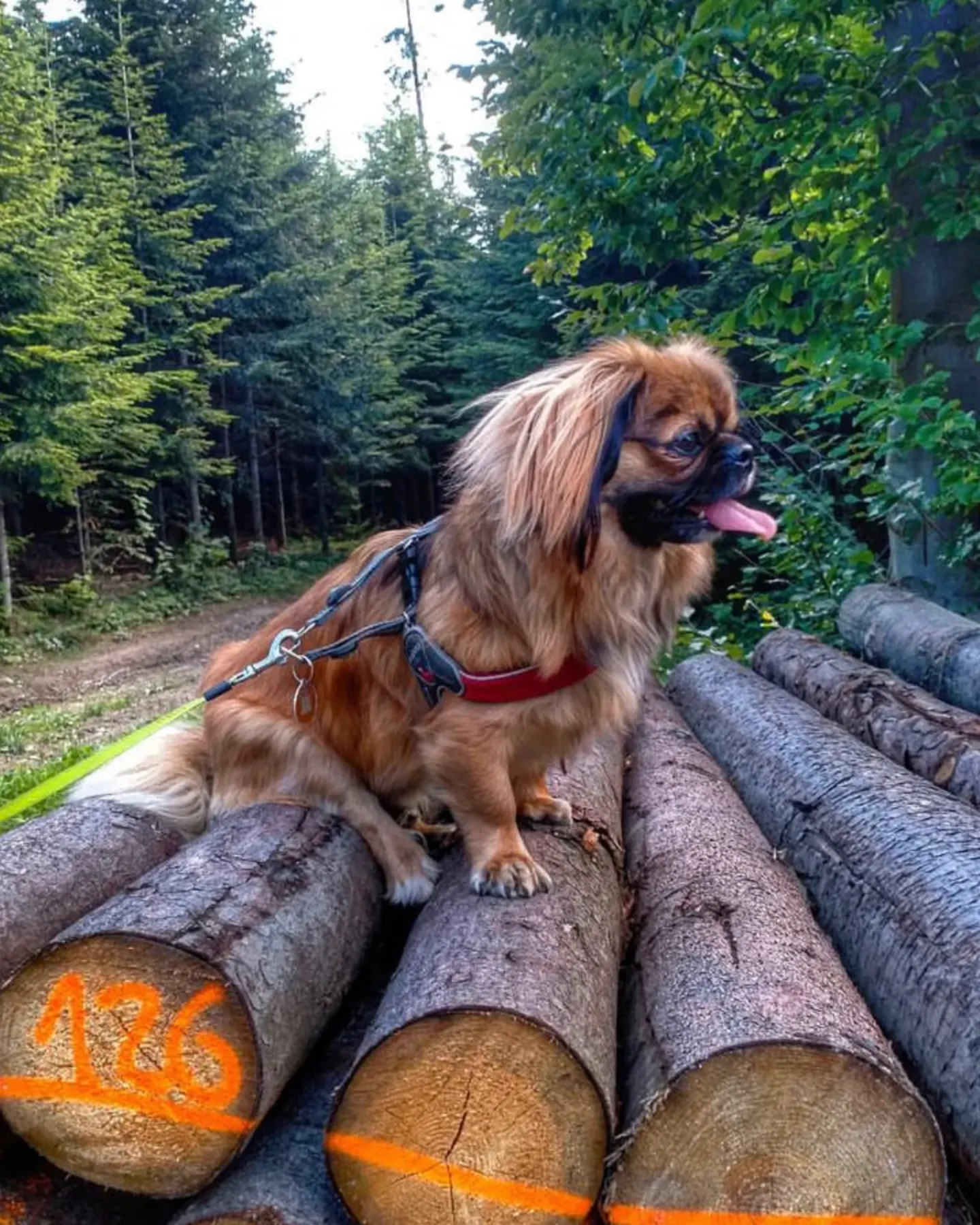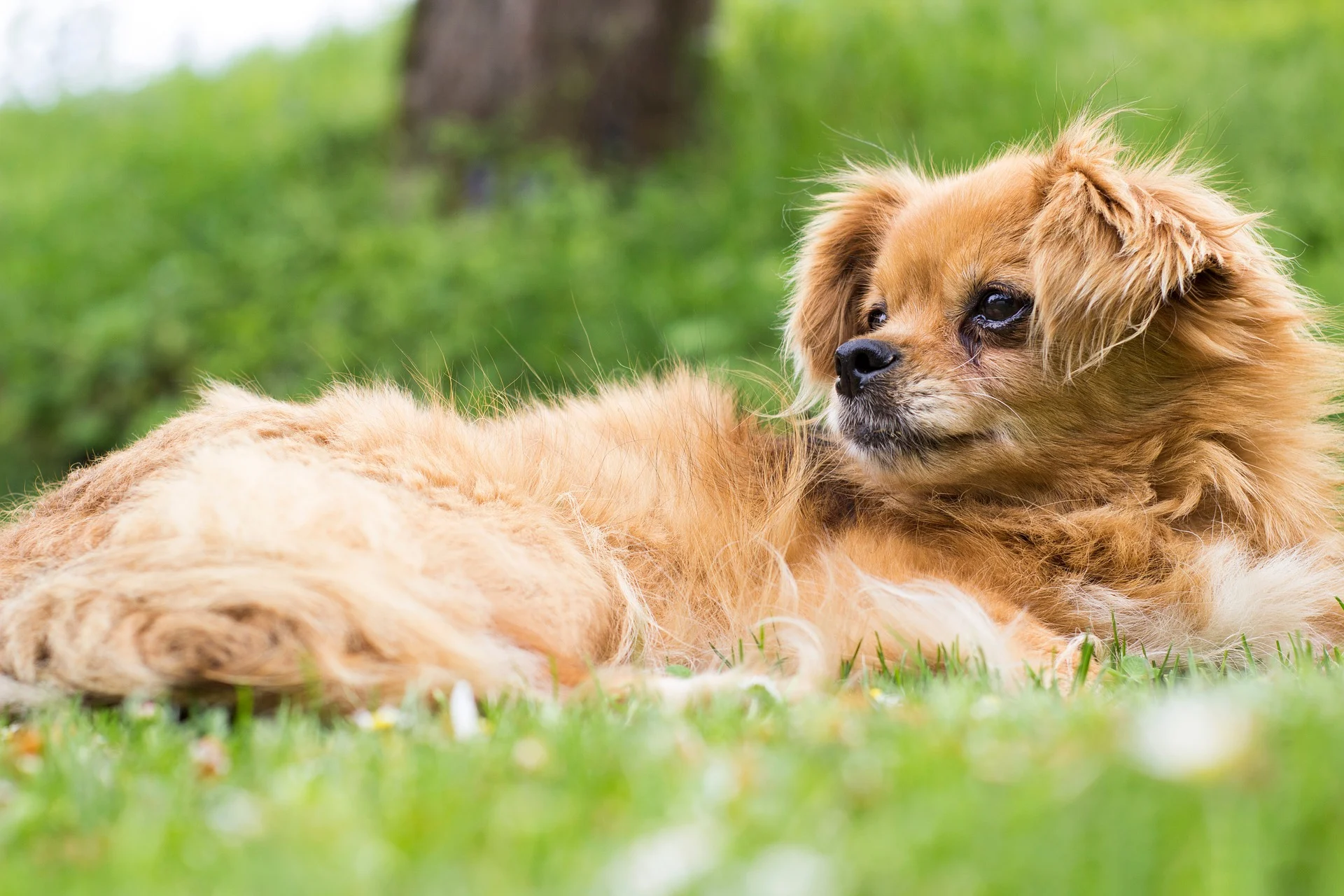Given that the Pekingese used to be a favorite of the emperor, it’s not surprising that he has a high opinion of himself. At the Chinese imperial court, he was very respected, and he still knows that. A Pekingese will welcome you with pride and honor. He knows that his ancestors were close to royalty, and he still wants to be treated with the respect that comes with that. He knows who he is and how important he is to the people who live with him.
Pekingese are very loving and affectionate with their families, but they are aloof and almost wary of people they don’t know. This makes them good watchdogs because they like to bark when strangers come close. Even though kids are always interested in small dogs, a Pekingese is not a good choice for a family with young children who might accidentally hurt him. The Peke won’t let himself be grabbed or poked, and he won’t be afraid to fight back.
The Pekingese may be a good choice if you want a loyal, loving friend who will treat you with respect and dignity and expects the same from you. They need someone who understands their individual needs and is willing to make room in their lives for their unique personalities. The Pekingese will give you all the love and affection that can come from a small dog with a big heart.

Source: Instagram (@zzinbba)
History of the Pekingese
The story of how the Pekingese came to be is actually pretty cute. A Chinese legend says that a lion fell in love with a marmoset, which is a type of monkey. So that he could marry the woman he loved, the lion begged Buddha to make him smaller while letting him keep his big lion heart and character. Buddha agreed, and from their union came the dogs of Fu Lin, which are the Chinese lion dogs.
Maybe that’s not exactly how the Pekingese came to be, but it’s still an interesting story. DNA tests show that the breed is one of the oldest dog breeds out there. People think that the Peke has been around in China for at least 2,000 years. They were friends of noblesand princes, and they were named after the city of Peking, which is now called Beijing.
The Opium War in 1860 brought him to the attention of people in the West. When British troops took over Peking and went to the imperial palace, they found five Pekingese dogs guarding the body of their mistress, who had killed herself rather than be taken prisoner. The dogs were taken as war prizes and given to the Royal family.
Peke’s popularity naturally spread to the United States. In 1906, Rascal was the first Pekingese to be registered with the American Kennel Club. In 1909, their national breed club, the Pekingese Club of America was founded. They are one of the most popular toy dog breeds here in the United States, and it’s not hard to see why.
Appearance
Pekingese are sweet, small dogs that are just the right size to sit on their owners’ laps. The Pekingese can weigh up to 14 pounds and stand 6 to 9 inches tall, but under all that soft fur, they are pretty muscular. His coat is long and silky and needs regular brushing. Most people think of this breed as being golden, but they come in almost every color.
However, there is also a smaller version of the Pekingese breeds, called the sleeve Pekingese. Sleeve dogs are canines of the Pekingese breeds that are lighter than 6 pounds. The sleeve Pekingese was the most popular variation during the breed’s development in China.
Pekingese usually have black eyes that are so dark when they look straight ahead that you can barely see any white. He is a brachycephalic breed, which means that his face is squashed and flat. That can make it difficult for him to breathe, especially during warmer months and physical activity. His ears are shaped like hearts and hang flat.
Personality of the Pekingese
This toy breed is the epitome of a lapdog, and at home, it’s pretty easygoing. But the Pekingese is also a very alert little dog. If he senses something scary, like the mailman or a neighbor walking by, he will bark loudly to warn you. Even though he looks silly, the Pekingese is a strong dog who is braver and tougher than he looks.
The Peke is a lively, friendly, and good-natured dog with a royal air, a sense of self-importance, and a stubborn streak. He will respect you if you respect him. He is loyal to his people and looks out for them by barking at strangers. Even though they love their families, Pekingese can be shy around new people. Early socialization will help your Pekingese puppy be comfortable around strangers and keep him from barking.
Like all dogs, Pekingese need to meet lots of different people, see lots of different things, hear lots of different sounds, and do lots of different things when they are young. Socializing your Peke puppy will help him or her grow up to be a well-rounded dog. Putting him in a kindergarten class for puppies is a good start. You can help him improve his social skills by having people over often, taking him to busy parks and stores that allow dogs, and taking him on long walks to meet neighbors.
When you first meet a Pekingese dog, it might seem aloof and maybe even a little snobbish, but to its owner, it is smart, funny, and full of personality. The Peke is an adaptable dog that can live with almost anyone, even if they live in an apartment or have never had a pet before. But they tend to stay close to one person who takes care of them the most.
Are they good family dogs?
Pekingese get along well with other dogs and cats. They’re pretty chill with other animals. They can be great family dogs, but they don’t like to play all day every day, so families with older children may be better off with them. As with all dogs, children need to be watched when Pekingese play, and they need to be taught how to interact with (and respect) pets in the right way.
A Pekingese is not a good choice for a family with young children who might accidentally hurt him. The Peke won’t let himself be grabbed or poked, and he won’t be afraid to fight back. Always show kids how to approach and touch dogs, and always watch when young kids and dogs are together to make sure no one bites or pulls on the other’s ears or tails. Teach your child never to go up to a dog while he is sleeping or eating or to try to take the dog’s food.
Pekes like to hang out with other Pekingese, but with early socialization, they can learn to get along with other dogs (and cats) and may even rule over dogs that are ten times their size.

Source: Instagram (@pekinczyktaco)
Living with a Pekingese
Pekingese don’t need much space because they love sitting on their owners’ laps. They form such close bonds with their owners that if they are left alone for too long, they can get separation anxiety. If you have to be away from home for a long time, they are not the right breed for your home.
They are perfectly fine with living in small spaces, but they won’t mind a mansion either. Even though they have a thick coat, Pekingese should not live outside. They can’t handle the heat because of their short noses, so they need to live in a place with air conditioning.
Your Peke won’t ever go jogging with you, but he’ll enjoy short walks around the block and going with you when you run errands. Like all dogs, they like to go places and see things. But they can get their physical activity even when living in a city apartment.
This lion’s long mane and thick double coat need a lot of care. At least an hour of brushing a week is needed to get rid of loose hairs and stop mats from forming. Pekingese need to have their nails trimmed, their ears checked and cleaned, and their teeth brushed regularly, just like any other dog.
Pekes don’t need much exercise, but they can enjoy being agile and playing games at their own pace. But most of the time, they’ll be happy to play with toys in the living room and then cuddle up for a movie. They can be hard to train because they are independent and like to be taken care of. You’ll need to be consistent and give your pup positive reinforcement if you want it to learn basic commands and maybe even a few tricks.
Grooming
The Pekingese has a long, rough, straight topcoat with a thick, soft undercoat. The Pekingese looks like a lion because he has long hair on his neck and shoulders with shorter hair on the rest of his body. He has long feathers on the backs of his legs and on the tips of his toes. The ears and tail have even longer feathers.
His lion’s mane can be any color or pattern, like black and tan, fawn or red brindle, particolor, or black and tan with white markings. He can sometimes have a black mask. No matter what color the coat is, the skin on the face, nose, lips, and eye rims is always black.
You can brush your Peke’s coat once a week with a small bristle brush, curry brush, or shedding comb. Lightly mist the coat with water before you brush it to keep the hair from breaking. Because his hair is so long, he can get tangles easily, that’s why daily brushing is a must.
These dogs also have skin folds, so you have to take good care of them as well in order to prevent skin fold dermatitis. Use a damp cotton ball to clean their skin folds, and dry it with a clean towel afterward. If your Peke gets wet, make sure to dry the folds of skin until there is no more moisture.
If you need to, give your Pekingese a bathe once or twice a month. Use a shampoo made for dogs to keep his fur from drying out. Don’t forget to clean their ears, trim their nails, and brush their teeth daily to remove tartar and bacteria and prevent all kinds of dog dental problems.
Training
These dogs are strong-willed and can be hard to train. No one knows for sure if this breed is stubborn and independent because they are smarter than most dogs or if they are just that way. Any way you look at it, it will take time and patience to teach them new tricks. The best plan of action? Keep things interesting and fun.
Use food that he really likes to keep his attention. It’s fine to just use some of his regular kibble, but make sure to add something extra tasty, like small bits of cheese or hot dog, to keep him interested.
If the Pekingese is not trained properly, it is likely to get “small dog syndrome.” Always be the alpha dog if you want them to be well-behaved and easy to handle. If you don’t, they may develop bad habits, such as being stubborn, showing jealousy, having separation anxiety, being too protective, growling, snapping, biting, or growling a lot for no reason, and barking all the time.

Source: Instagram (@ponpon8476)
Exercise
Your Peke will need to run around for at least half an hour every day. Because their noses are flat, it’s important not to push them too hard or they might find it hard to breathe. They should be fine with a few shorter walks with some time off-leash in between. Remember to take a break if it looks like your dog is struggling.
They don’t need a lot of exercise, but even those who don’t like to work out (aka are “lazy”) should get some. Many are quiet and don’t bark much, but if someone comes to their door, they let you know.
Because these dogs don’t do too well in the heat, limit their exercise in the summer. Make sure you go on walks while the temperatures are still bearable for your dog. Like early in the morning, or a bit later in the evening. As we explained, these pups have trouble breathing as it is. High temperatures can only make it worse.
Health of the Pekingese
The Peke is an overall healthy breed that lives from 13 to 15 years. The biggest health issue for these canines is related to the fact that they are a brachycephalic breed. That means that they have unique needs, and can’t exercise as much as other dogs, or tolerate the heat very well.
Always make sure you buy your puppy from a reputable breeder who tests dogs for genetic diseases. That is the most important thing you can do to make sure your dog is healthy, in addition to taking him to the vet reguraly.
The most common health conditions that Peke dogs are prone to include:
Brachycephalic syndrome: Most brachycephalic dogs snort and snuffle a little bit. But others’ breathing, coughing, gagging, fainting, and falling down get worse, and they can’t exercise as much. Overheating is especially dangerous for these breeds because panting causes the airway to swell and narrow.
Keratoconjunctivitis sicca or dry eye: Dry eye happens when the eyes don’t make enough tears to stay moist.
Progressive retinal atrophy: This is a disease that causes the photoreceptors at the back of the eye to die. Eventually, this leads to blindness. PRA can be found years before a dog shows signs of going blind.
Cleft palates: A cleft palate is a split in the roof of the mouth that can be on one side or both sides. The split can be small or big. A cleft palate can affect the hard palate, the soft palate, or both. It can also cause a cleft lip.
Conclusion
In conclusion, the Peke is a loyal companion with a large heart, but with an even bigger ego. They have the personality of a giant lion squeezed into an adorable and small package. These purebred dogs know how important they were to the royals back in history, and they feel like blue blood is running through their veines as well.
But the moment you look into his brown eyes, you will immediately feel like he is your best friend. Even though they think very highly of themselves, these pups are still very loyal and able to give their love back. Peke people will always have a mini lion next to their side to keep them company and give emotional support.
But you have to keep in mind that these dogs have unique needs. They need a lot of daily maintenance, and while they can make great family companions, it isn’t a good idea to mix them with very young children. They don’t appreciate rough play, and they aren’t afraid to fight back. Pekes have gentle backs, and your kids could even hurt their spinal cord.

